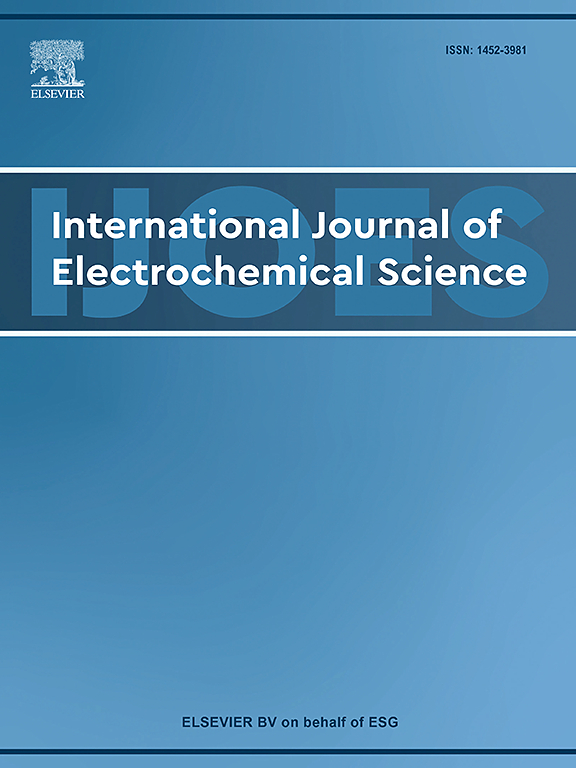Non-linear statistical modeling and optimization of the electro-Fenton process for tramadol removal from aqueous media
IF 1.3
4区 化学
Q4 ELECTROCHEMISTRY
International Journal of Electrochemical Science
Pub Date : 2025-02-24
DOI:10.1016/j.ijoes.2025.100977
引用次数: 0
Abstract
Advanced statistical models incorporating quadratic, cubic, and interaction terms were developed to predict and optimize the electro-Fenton (EF) process for tramadol (TRA) degradation and mineralization in aqueous media. The influence of key operational parameters, including Fe²⁺ concentration, current density, reaction time, and initial contaminant concentration, was systematically analyzed to capture complex, non-linear interactions governing the EF process. The models were calibrated and validated using experimental data, and they demonstrate 100 % TRA degradation within 12 min. and a 94.3 % reduction in chemical oxygen demand (COD) after 6 h. under optimal conditions. These data provided a robust foundation for predictively modeling the degradation kinetics and mineralization efficiency. The degradation model (R2=0.8825) effectively described TRA removal kinetics, accounting for saturation effects and parameter interactions to enhance predictive accuracy under varying conditions. The mineralization model (R2=0.9266) accurately represented COD reduction over time, demonstrating the critical role of current density and Fe²⁺ concentration. Additionally, the Instantaneous Current Efficiency (ICE) model (R2=0.9815) optimized operational conditions by enhancing pollutant removal efficiency while reducing energy losses associated with parasitic reactions. This study highlights the potential of advanced statistical modeling to enhance the efficiency, scalability, and industrial applicability of the EF process for pharmaceutical contaminant removal. The proposed modeling framework could be extended to optimize the treatment of other emerging contaminants, supporting the large-scale deployment of EF technology in wastewater treatment.
电fenton法去除水中曲马多的非线性统计建模与优化
采用二次项、三次项和相互作用项建立了先进的统计模型,用于预测和优化水介质中曲马多(TRA)降解和矿化的电fenton (EF)过程。系统分析了关键操作参数(包括Fe 2 +浓度、电流密度、反应时间和初始污染物浓度)的影响,以捕获控制EF过程的复杂非线性相互作用。使用实验数据对模型进行了校准和验证,结果表明,在12 min内,TRA降解率为100% %。6 h后化学需氧量(COD)降低94.3 %。在最佳条件下。这些数据为预测模拟降解动力学和矿化效率提供了坚实的基础。降解模型(R2=0.8825)有效地描述了TRA去除动力学,考虑了饱和效应和参数相互作用,以提高不同条件下的预测准确性。矿化模型(R2=0.9266)准确地代表了COD随时间的还原,证明了电流密度和Fe 2⁺浓度的关键作用。此外,瞬时电流效率(ICE)模型(R2=0.9815)通过提高污染物去除效率,同时减少与寄生反应相关的能量损失来优化操作条件。这项研究强调了先进的统计建模的潜力,以提高效率,可扩展性和工业适用性的EF过程中去除药物污染物。所提出的建模框架可以扩展到优化其他新兴污染物的处理,支持EF技术在废水处理中的大规模部署。
本文章由计算机程序翻译,如有差异,请以英文原文为准。
求助全文
约1分钟内获得全文
求助全文
来源期刊
CiteScore
3.00
自引率
20.00%
发文量
714
审稿时长
2.6 months
期刊介绍:
International Journal of Electrochemical Science is a peer-reviewed, open access journal that publishes original research articles, short communications as well as review articles in all areas of electrochemistry: Scope - Theoretical and Computational Electrochemistry - Processes on Electrodes - Electroanalytical Chemistry and Sensor Science - Corrosion - Electrochemical Energy Conversion and Storage - Electrochemical Engineering - Coatings - Electrochemical Synthesis - Bioelectrochemistry - Molecular Electrochemistry

 求助内容:
求助内容: 应助结果提醒方式:
应助结果提醒方式:


